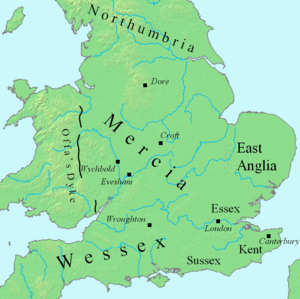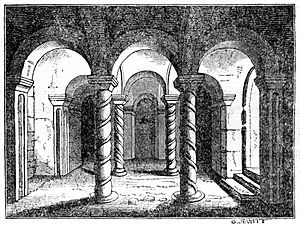Wiglaf of Mercia facts for kids
Quick facts for kids Wiglaf |
|
|---|---|

Wiglaf's name (spelled ƿiglaf, with a wynn) in the 825 entry of the [C] manuscript of the Anglo-Saxon Chronicle
|
|
| King of Mercia | |
| Reign | 827–829 (first time) |
| Predecessor | Ludeca |
| Successor | Ecgberht |
| Reign | 830–839 (second time) |
| Predecessor | Ecgberht |
| Successor | Beorhtwulf |
| Died | 839 |
| Burial | Repton Abbey |
| Consort | Cynethryth |
| Issue | Wigmund |
Wiglaf (died 839) was a king of Mercia, an old Anglo-Saxon kingdom in what is now England. He ruled two times: first from 827 to 829, and then again from 830 until his death. We don't know much about his family background. The 820s were a time when many different families fought for control in Mercia. Wiglaf's grandson, Wigstan, was later said to be related to Penda of Mercia, a very powerful king from the 600s. This means Wiglaf might have been from Penda's family too.
Wiglaf became king after Ludeca, the previous king, was killed while fighting against the kingdom of East Anglia. Wiglaf's first time as king happened when the kingdom of Wessex was becoming very strong under its king, Ecgberht. In 829, Ecgberht took over Mercia and forced Wiglaf off the throne. Ecgberht ruled Mercia for about a year. But in 830, Wiglaf got his kingdom back. He probably fought to get it back, but he might have still been under Ecgberht's power. Mercia never got back its control over the southeastern kingdoms, but it did regain Berkshire and possibly Essex. Wiglaf seemed to make Mercia strong again, but this didn't last. Later, Mercia was divided between Wessex and the Vikings.
Wiglaf died around 839. After him, Beorhtwulf became king. Some stories say Wiglaf's son, Wigmund, ruled for a short time before Beorhtwulf. Wiglaf is buried in Repton, a village near Derby.
Contents
Mercia's Place in History

For most of the 700s, Mercia was the most powerful Anglo-Saxon kingdom. Offa, who died in 796, was a very strong Mercian king. After him, Coenwulf kept Mercia's power over kingdoms like Kent, East Anglia, and Essex. He also often attacked into what is now Wales, crossing Offa's Dyke.
Coenwulf died in 821. This started a time when the map of England changed a lot. After Coenwulf, his brother Ceolwulf became king, but he ruled for only two years before being removed from power.
The Rise of Wessex
The next king, Beornwulf, was not from the royal family. In 823, he defeated the Welsh kingdom of kingdom of Powys. This showed Mercia was still a strong military power. However, in 825, Beornwulf was badly beaten by Ecgberht, King of Wessex, at the Battle of Ellendun. The next year, Beornwulf died trying to invade East Anglia.
His successor, Ludeca, also invaded East Anglia and died there in 827. These quick defeats weakened Mercia. At the same time, the kingdom of Wessex in the south was growing much stronger. This was the situation when Wiglaf became king.
Wiglaf's First Time as King
The Anglo-Saxon Chronicle is an old record of English history. It says Wiglaf became king in 827. The record states: "Here Ludeca, King of Mercia, was killed, and his five ealdormen with him, and Wiglaf succeeded to the kingdom."
In 829, Ecgberht of Wessex attacked Mercia and forced Wiglaf off his throne. Before this, Ecgberht's victory in 825 had already made Mercia lose control of the southeastern kingdoms like Kent, Sussex, Essex, and East Anglia. The failed attacks by Beornwulf and Ludeca on East Anglia also confirmed Mercia's loss of that kingdom.
Ecgberht's defeat of Wiglaf in 829 meant he now controlled most of southern England. Later that year, Ecgberht even received the loyalty of Eanred of Northumbria, a king from the north. Because of these events, the writer of the Anglo-Saxon Chronicle called Ecgberht the eighth bretwalda. This old English word means 'Ruler of Britain'.
Ecgberht ruled Mercia until sometime in 830. He even made coins in London that said "Rex M," which means "King of Mercia."
Wiglaf's Second Time as King
The Chronicle says that in 830, Wiglaf "obtained the kingdom of Mercia again." Historians usually believe this means Ecgberht no longer controlled Mercia. Some historians think Wiglaf fought to get his kingdom back. If Ecgberht had simply given it to him, the Chronicle would likely have said so.
Mercia Regains Power
A document from 836 shows Wiglaf acting as an independent ruler. It describes a meeting in Croft, Leicestershire. The Archbishop of Canterbury and eleven bishops were there, including some from Wessex. Wiglaf called them "my bishops, duces, and magistrates." This shows he had control over his own land and some power over the church in the south. It was important that Wiglaf could still gather such important people.
Essex, which used to be controlled by Mercia, might have come back under Mercian rule. A king from Essex, named Sigeric, was called a minister (a high-ranking official) of Wiglaf's in a document from between 829 and 837. London, where Ecgberht had lost control of the coin-making, stayed a Mercian town during Wiglaf's second reign and after. Berkshire also seems to have returned to Mercian control.
A document from 831, which Wiglaf called "the first year of my second reign," was issued near Droitwich. In this document, Wiglaf does not mention Ecgberht having any power over him. He also admits that he was temporarily removed from power. In East Anglia, King Æthelstan started making his own coins around 830. This happened after Ecgberht's power was reduced and Wiglaf returned to Mercia. This shows East Anglia was also becoming independent.
Why Did Things Change?
Historians have looked at why Wessex suddenly became so powerful in the late 820s, and then why it didn't keep that strong position. One idea is that Mercia's royal family was unstable, with many different people trying to become king.
Another idea is that Wessex's success might have depended on support from the Carolingian rulers in Europe. But in the 820s and 830s, the Carolingian empire faced problems, including a rebellion against their ruler, Louis the Pious. These problems might have stopped Louis from helping Ecgberht. If so, the kingdoms in England would have had to find their own balance of power without outside help.
Wiglaf's recovery was not complete. Ecgberht's power was less after 830, but Mercia never fully got back control of the southeast, except maybe for Essex. East Anglia also stayed independent.
Coins and Charters
Coins from Wiglaf's time as king are very rare. There are only a few, and most are from his first reign. This might suggest that Wiglaf was still under Ecgberht's power after 830, but most historians think he became independent.
What Were Charters?
Charters were important documents used in Wiglaf's time. They were official papers that granted land or special rights to people or to churches. Kings would sign these charters to show they had the power to give the land.
One of Wiglaf's charters from 836 gave special rights to a monastery in Hanbury. But it said the monks still had to help build strong walls (ramparts). This shows that protecting the kingdom was a big concern. Wessex charters didn't start including such rules until 846. These rules were important because Viking raids were becoming a problem across Britain. Vikings had been attacking since at least 793, and by 835, their raids were a serious worry for kings.
The 836 charter also mentions the trimoda necessitas. This was a set of three duties that kings expected from their people. These duties were:
- Building royal homes.
- Paying feorm, which was like a food tax to the king.
- Providing hospitality (food and lodging) for the king's servants.
Wiglaf's Death and Burial
We don't know the exact date Wiglaf died from old records. But we can figure it out from the reigns of the kings who came after him. Burgred was driven out by the Vikings in 874, after ruling for 22 years. This means he became king in early 852. The king before Burgred, Beorhtwulf, ruled for 13 years. This fits with his charters. So, it seems Wiglaf's reign ended in 839.
Some stories say that Wiglaf's grandson, Wigstan, died in 849. These stories also say Wigstan's father, Wigmund (Wiglaf's son), was king for a short time. But this is the only record of Wigmund being king, so it might not be true. We don't know who Beorhtwulf's family was. It seems that there was often fighting over who would be king in Mercia. This was different from Wessex, where King Ecgberht started a family line that ruled for most of the 800s.
Wiglaf was buried in Repton, in a crypt that you can still see today. The monastery church there was probably built by Æthelbald of Mercia to be a burial place for kings. Wiglaf's grandson, Wigstan, was also buried there. The arched ceiling and columns in the crypt might have been built around Wiglaf's time.
See also


